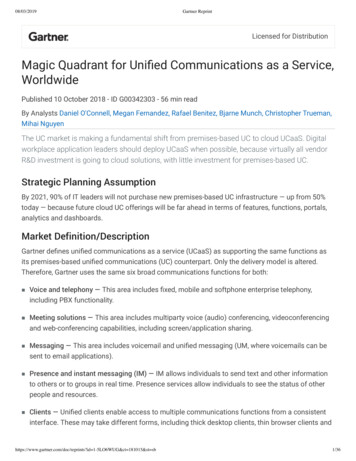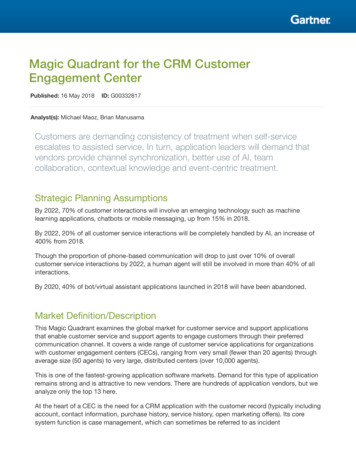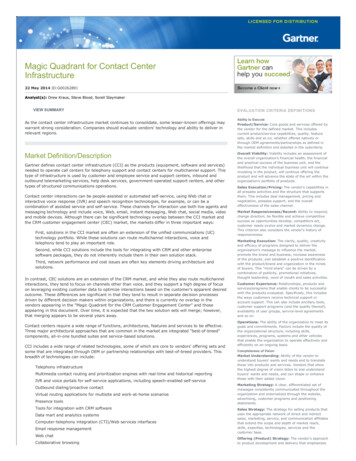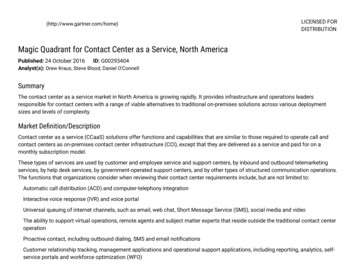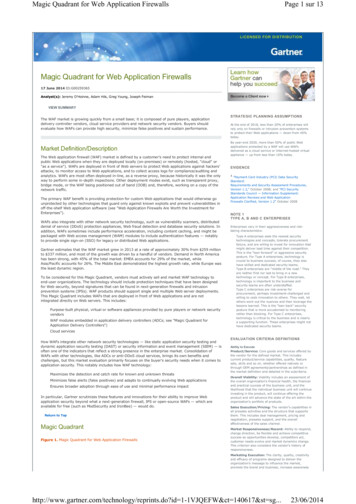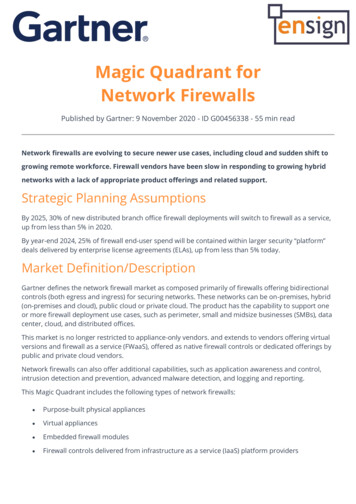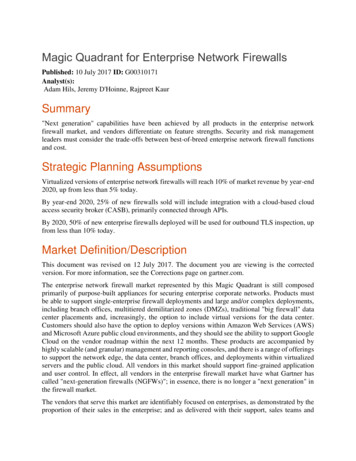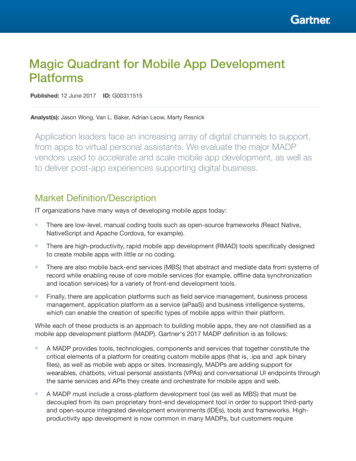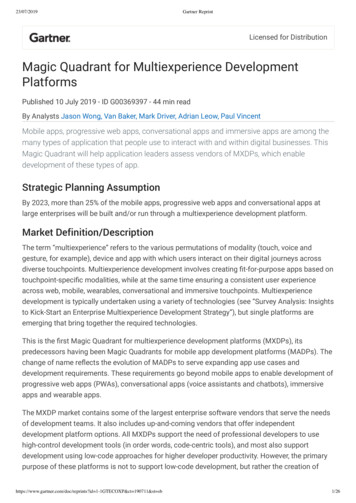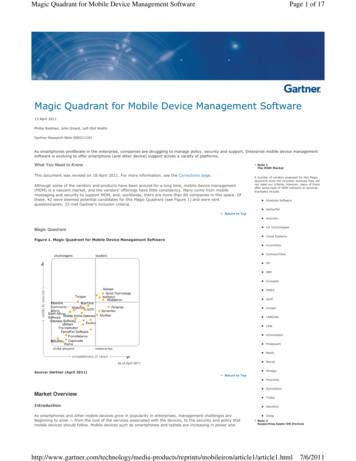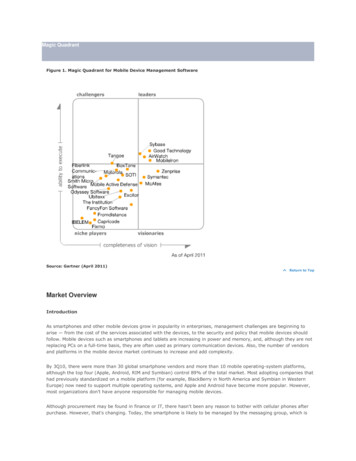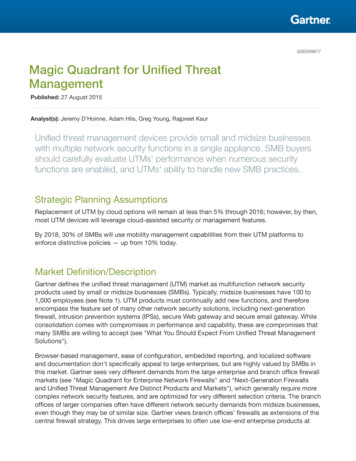
Transcription
G00269677Magic Quadrant for Unified ThreatManagementPublished: 27 August 2015Analyst(s): Jeremy D'Hoinne, Adam Hils, Greg Young, Rajpreet KaurUnified threat management devices provide small and midsize businesseswith multiple network security functions in a single appliance. SMB buyersshould carefully evaluate UTMs' performance when numerous securityfunctions are enabled, and UTMs' ability to handle new SMB practices.Strategic Planning AssumptionsReplacement of UTM by cloud options will remain at less than 5% through 2016; however, by then,most UTM devices will leverage cloud-assisted security or management features.By 2018, 30% of SMBs will use mobility management capabilities from their UTM platforms toenforce distinctive policies — up from 10% today.Market Definition/DescriptionGartner defines the unified threat management (UTM) market as multifunction network securityproducts used by small or midsize businesses (SMBs). Typically, midsize businesses have 100 to1,000 employees (see Note 1). UTM products must continually add new functions, and thereforeencompass the feature set of many other network security solutions, including next-generationfirewall, intrusion prevention systems (IPSs), secure Web gateway and secure email gateway. Whileconsolidation comes with compromises in performance and capability, these are compromises thatmany SMBs are willing to accept (see "What You Should Expect From Unified Threat ManagementSolutions").Browser-based management, ease of configuration, embedded reporting, and localized softwareand documentation don't specifically appeal to large enterprises, but are highly valued by SMBs inthis market. Gartner sees very different demands from the large enterprise and branch office firewallmarkets (see "Magic Quadrant for Enterprise Network Firewalls" and "Next-Generation Firewallsand Unified Threat Management Are Distinct Products and Markets"), which generally require morecomplex network security features, and are optimized for very different selection criteria. The branchoffices of larger companies often have different network security demands from midsize businesses,even though they may be of similar size. Gartner views branch offices' firewalls as extensions of thecentral firewall strategy. This drives large enterprises to often use low-end enterprise products at
their branch offices to ensure interoperability, and to take advantage of economies of scale ingetting larger discounts from their firewall vendors. For these reasons, Gartner allocates branchoffice firewall revenue to the enterprise firewall market, not the UTM market.SMBs should be skeptical of the aspirational message from UTM vendors about the exaggeratedbenefits of feature consolidation. Security buyers should instead evaluate UTM devices based onthe controls they will actually use, the performance they will get for those features, and the quality ofvendor and channel (and managed services) support that is available.Page 2 of 27Gartner, Inc. G00269677
Magic QuadrantFigure 1. Magic Quadrant for Unified Threat ManagementSource: Gartner (August 2015)Gartner, Inc. G00269677Page 3 of 27
Vendor Strengths and CautionsAker Security SolutionsBased in Brazil, Aker Security Solutions is a network security vendor. Its portfolio has included UTMsolutions (Aker Firewall UTM) since 1997, as well as secure Web gateway and secure email gateway.Aker Firewall UTM is composed of 14 models, with two models with wireless capabilities, allrefreshed in 2013. Its single virtual appliance model can also run on VMware, Citrix XenServer andMicrosoft Hyper-V.In the past months, Aker has upgraded its IPS signature base, added Internet Message AccessProtocol over SSL (IMAPS) support and a VPN client for iOS and Android through OpenVPNintegration. It also now offers an option to support multiple users on a Windows Terminal server orCitrix workstation.Aker is assessed as a Niche Player, because it operates mostly in Brazil and does not compete yetinternationally. Aker Firewall UTM is a good shortlist candidate for small and midsize organizationsin Brazil.Strengths Aker Firewall UTM provides a comprehensive set of UTM features, including application control,a variety of VPN options and link load balancing, wireless security, Secure Sockets Layer (SSL)VPN, and two choices each for an antivirus engine. Aker's clients and its channel partners cite ease of use, the vendor's local presence in Brazil,and the quality of its support as reason to select the vendor's UTM. Aker is one of the few vendors that provide graphical user interface (GUI), documentation andsupport in Portuguese, in addition to English.Cautions Aker does not appear in UTM evaluations outside of Brazil yet. Aker has a smaller development team for its UTM, and therefore is slower to release newfeatures than many of its international competitors. Gartner believes that this is noticeable inupper-midmarket organization selections. Aker's UTM lacks network sandboxing and fine-grained role definition for centralizedmanagement, and does not provide a Web-based SSL VPN for remote users (using a Javaapplet is required). Some clients report that management console and reporting look dated. Aker does not provide an embedded Web interface that the smaller organizations appreciate.Instead, Aker's UTM always requires the installation of a management software component(Aker Control Center).Page 4 of 27Gartner, Inc. G00269677
Barracuda NetworksBased in Campbell, California, Barracuda Networks is a large vendor providing network security,backup and infrastructure solutions, including Web and email security, Web application firewall,application delivery controllers and data backup. In February 2013, Barracuda released a newproduct line, the Barracuda Firewall (X series), to complement Barracuda NG Firewall (F series), itsincumbent range of firewalls, which are oriented toward larger enterprises' needs. BarracudaFirewall is composed of seven models, including two with wireless capabilities, but is still notavailable as a virtual appliance. It embeds a Web interface, designed for simpler use cases, and canbe managed in the Barracuda Cloud Control portal.In 2014, the vendor introduced Barracuda Security Suite, a single integrated server that offers fullfeatured versions of Barracuda Firewall, Barracuda Spam Firewall and Barracuda Web Filter. Thevendor also recently released application-based link-load balancing and customized block pagesfor its Web proxy.Barracuda is assessed as a Niche Player mainly because of the limited reach for its UTM productline outside of the EMEA region. The Barracuda Firewall series is a good shortlist candidate forNorth American and European SMBs that already use other Barracuda products, have stringentbudget constraints or prize ease of deployment as a primary requirement.Strengths Barracuda has strong market share among SMBs, and customers benefit from good globalsales and support presence. Barracuda has greatly increased partner training and certificationfor the Barracuda X Series in North America and Europe. Surveyed partners and customers consistently cite knowledgeable, responsive customersupport as a clear differentiator from competitors. Gartner clients report that they like Barracuda's simple licensing, and that unlike manycompetitors, the price for software options is reasonable. Barracuda Cloud Control is includedat no additional charge. Barracuda Networks offers a 30-day refund plan and a replacement program that includes afree new appliance every four years, keeping the average appliance life at below four years.Cautions The Barracuda X Series partners and customers cite the need for more advanced features,including higher quality application and identity control. Its cloud-based sandboxing feature iscurrently available for Web traffic only. The Barracuda X Series has not been scrutinized by any major third-party testing labs and has alimited number of certifications.Gartner, Inc. G00269677Page 5 of 27
Gartner believes that, while Barracuda has correctly assessed that SMB and enterprises havedifferent needs, its two firewall lines still have more overlaps than differences, whichcomplicates the work of its channel and can confuse SMB buyers.Check Point Software TechnologiesCheck Point Software Technologies, headquartered in Tel Aviv, Israel, and with operationsworldwide, is a large pure-play security company and, according to Gartner, has the largestenterprise firewall market share. Its SMB product line is mostly across the 600, 1100, 2000 and4000 lines of appliances. UTM can also be delivered via the cloud-based Capsule Cloud service, asa virtual appliance in the Check Point Security Gateway Virtual Edition, or on Amazon Web Services(AWS), Microsoft Azure and OpenStack. Fundamental to Check Point security gateway offerings isthe set of software options referred to as Software Blades, which can be grouped together inbundles. SMBs often choose more blades than enterprises would.Recent features includes mobile security features (Check Point Capsule), software-basedperformance improvement for traffic processing, improved coverage of industrial control system(ICS) protocols and a new threat mitigation software blade, Threat Extraction, which uses contentreconstruction to remove suspected malicious content during transit.Check Point is rated as a Leader because of its continued presence on SMB customer shortlists, itsgeographic coverage and its ability to beat competition based on its unique features. Check Point isa good choice for SMB organizations that do not consider low price as the most important criterion.Strengths Check Point's reporting and management console is consistently very highly rated by midsizecompanies that need to handle any complexity. The different support levels and options providea good variety of options and prices. Check Point's UTM solutions benefit from its enterprise-level security features, such asThreatCloud and Anti-Bot software options, in addition to the strong IPS module, which are allbacked up by Check Point's large threat research team. Check Point provides a strong set of options to protect against custom malware with itssandboxing subscription (Threat Emulation Cloud Service), a variety of threat intelligence feeds(ThreatCloud IntelliStore) and a recently released feature that can automatically removesuspected harmful content from downloaded file (Threat Extraction). Check Point UTM integrates with the vendor's cloud-based security service for mobile andremote users, providing a unified security policy for mobile and corporate users. Check Point's strong investment and persistent strategy to address SMB clients translates intoa good execution on its UTM roadmap.Page 6 of 27Gartner, Inc. G00269677
Cautions Gartner clients often cite price as the primary reason for not selecting Check Point solutions;however, this caution will not apply where best-of-breed features are sought foremost. Gartner sees Check Point mostly selling to its existing client base; however, Check Point hasincreased emphasis on its SMB value-added reseller (VAR) support program since the lastedition of this Magic Quadrant. Check Point offers many Software Blades and keeps adding new ones. It has made goodprogress in simplifying the sales offering with bundles, but resellers and clients report that theyfind it difficult to assess the overall performance impact of enabling more than a few optionssimultaneously. Check Point changes in legacy SMB branding strategy could cause some confusion in themarket; however, this will diminish if the current strategy is maintained.CiscoCisco, based in San Jose, California, has a complete access-layer product offering across wiredand wireless, making it the largest network infrastructure provider. The vendor also owns a broadsecurity portfolio, including secure email gateway, secure Web gateway, stand-alone IPS, enterprisefirewall and UTM.Since its acquisition of Sourcefire in 2013, Cisco is gradually integrating Sourcefire's IPS into itsexisting product lines. Cisco's strategy for SMBs mainly relies on its cloud-managed Meraki MXappliances, although they also offer the ASA 5500-X Series (five models) for small and midsizecompanies.Recent product news includes further integration of Sourcefire IPS into the Cisco ASA product line.Cisco also offers Meraki UTM models with 802.11ac wireless capabilities, GeoIP blocking andpolicy-based routing.Cisco is assessed as a Challenger because it has solid presence in midmarket organizations, buthas yet to provide a harmonious vision for all the UTM use cases. Cisco is a good choice for itsexisting customers and a good shortlist contender for distributed organizations.Strengths Cisco's brand and market presence are strong assets when targeting SMB clients that wantminimal complexity in their infrastructure and a simple procurement process. Cisco has recently introduced new ASA X Series models. The vendors' efforts to furtherintegrate the management of Sourcefire IPS on the ASA platform enhance its ability to answerthe stringent security needs of midmarket organizations looking for consolidated firewall andIPS modules.Gartner, Inc. G00269677Page 7 of 27
Cisco Meraki MX cloud-based centralized management offers a unified view of all Meraki UTM,wireless AP, switching and MDM products through the cloud.Cautions Cisco Meraki MX lacks email security, cloud-based sandboxing, SSL VPN for remote users andSSL decryption for HTTP. These functions are available in many competitive UTMs. The Meraki MX product line does not fully address all the use cases for SMB network securityneeds, and the management consoles for Cisco ASA X and Cisco Meraki are totally separate.This dual product-line offering available to SMB clients from Cisco might create complexity forsome clients using Cisco ASA on the core network, but considering Meraki MX for distributedoffices. Cisco does not generate
markets (see "Magic Quadrant for Enterprise Network Firewalls" and "Next-Generation Firewalls and Unified Threat Management Are Distinct Products and Markets"), which generally require more complex network security features, and are optimized for very different selection criteria.
